The conference theme centered around building meaningful relationships with others by acknowledging diverse identities and learning from them.
“Look Out. Look Out for Yourself. Look Out for Each Other. Look Out for Our Future” was the 13th annual Intersect Diversity and Leadership theme held on Friday, Sept. 22, hosted by the Center for Leadership and the Center for Race, Ethnicity and Diversity Education (CREDE).
Intersect is an annual two-day conference that examines diversity, leadership and the cross-sections between the disciplines. Attendees engage in dialogue and reflection through keynote speakers, educational sessions and roundtable discussions. The conference pillars, oppression, social change, power & privilege, inspire attendees to create positive change for the common good in their organizations and communities.
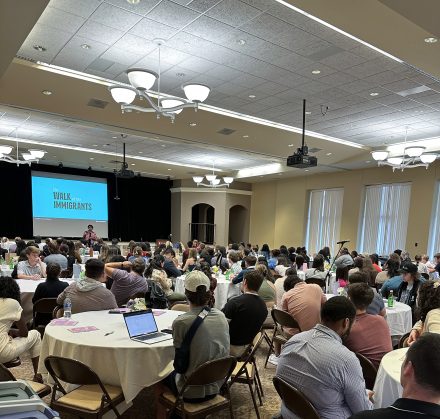
The “Look Out” theme centered around building meaningful relationships with others by acknowledging diverse identities and learning from them. The theme focused on helping attendees get comfortable with having difficult conversations that challenge their perspectives and viewing those conversations as opportunities to learn about one’s own identities.
“The message we wanted to put out for this conference was to create conversations around awareness of different identities intersectionality and how we all need to be united as one and support each other in the best ways that we know how,” Taylor Scott’25, Intersect Conference education committee chair, said. “Also, with this conference theme, we want to expand our minds and different things that we may not be completely knowledgeable about in order to be able to have positive impacts on the future,” Scott said.
The conference included educational sessions, information and discussions based on this year’s theme. Keynote speaker Saul Flores, philanthropist and photojournalist nationally recognized for his social impact projects, focused on all three elements of the conference theme through storytelling about his personal experiences and how these experiences impacted him to begin his work.
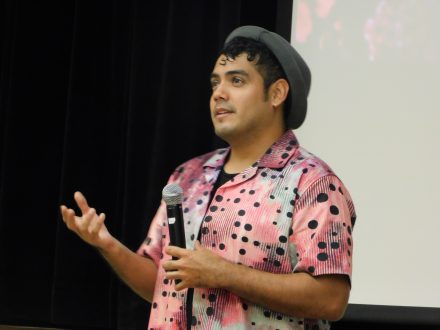
Flores shared stories of his family living in New York. His mother was a Mexican immigrant and his father was a Salvadoran immigrant. He began his address by discussing how “love is rooted in sacrifice.” One memory he shared about this was visiting the home of his mother’s employer, Margo, with his sister. Margo told the two that they could have anything in the pantry and there they found croissants in a brown paper bag. Their excitement grew when they discovered that the croissants were filled with the sweet hazelnut spread Nuttella.
“I had never seen a croissant before, but I knew it was bread, and I knew my sister was hungry, so I just gave it to her, and she ran away, and a couple of seconds later, she yelled back at me, and she goes ‘Saul, tiene chocolate’ (it has chocolate),” Flores said. “I was like, ‘No way.” So I take a big bite out of it, and it has Nutella. I’ve never had Nutella before. It is the best day of my life.”
As he was eating the croissant on the floor, his sister put on one of Margo’s shirts that his mother had folded and was spinning around the floor with the shirt on, a croissant in one hand and Nutella on her face. The two were ecstatic, feeling that they had all they needed, he said. Then the smell of bleach hit his nose.
“I’m looking at her and I’m like, ‘You’re so beautiful. Everything that I need is right here in you.’ And then I remember the smell of bleach. But at the time, I didn’t know what that smell was,” Flores said.
He walked around the corner and saw his mother scrubbing Margo’s floors. “And in that moment, I felt like my whole world came crashing down because my mom, my guardian angel, my protector, was scrubbing someone else’s house,” he said.
When much later he shared this story with a group of students from Dartmouth College, one asked Flores what it was like being hungry at such a young age. “I was kind of taken aback by that because I wasn’t really hungry. Right?” Flores said. “I was feeling love. And it’s the most beautiful type of love, right? It’s the love that parents have for their children, and we see it every single day when our parents would wake us up at four or five o’clock in the morning to catch the bus or when they would cook us food after the second or third shift. It’s a love that is rooted in sacrifice.”
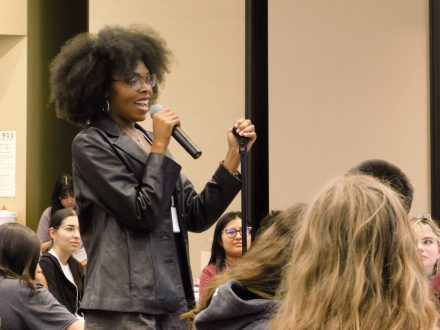
He then asked the audience to close their eyes and think of someone who sacrificed something for them to be in the room. After a couple of minutes, attendees shared with a person at their table about a person they thought had sacrificed for them. Several attendees also shared with the entire audience on the mic. After sharing, Flores explained, “So the reason I wanted to share is because I wanted you all to see how different we are as people and how important it is to celebrate those differences because I think those differences shape our stories.”
Flores also shared during his address a story about visiting his mother’s hometown of Atencingo, Mexico, where his grandmother and other family members continue to live. While visiting his grandmother with several friends from N.C. State University, he visited an elementary school that his grandmother called their beacon of hope. The elementary school was built in the 1970s to provide access and education to all the community’s children. When visiting the school, Flores states that they were greeted by the students with overwhelming joy. After the greeting and the students returned to their classes, he went to a third-grade classroom. Each classroom had a golden curtain that created a golden light in the room. He stated that he saw the typical classroom characters, such as studious students and jokesters. However, as the sun continued to illuminate the classroom, he saw the true condition of the school.
“The sun keeps passing by and this golden light creeps out of the room, and you began to see the school for what it really was. You saw the cinder block that was falling from the walls, the light bulbs that were hanging from the ceiling,” Flores said.
The school’s principal told him that the school he was visiting was the one his mother attended and would have been the one he would have attended if she had not migrated north. The principal also told Flores that he wanted him to take photos of the school for his mother to see the community waiting for her. He photographed portraits of students and ordinary moments between students. As he photographed, he had a revelation.
“It was through these photographs in this unexpected place that I discovered a community that I was meant to serve. See, I fell in love with these students, and I made a promise to celebrate education and access in whatever capacity I could,” Flores expressed.
Walk of the Immigrants
Flores also shared about how he was inspired to begin the Walk of the Immigrants project.
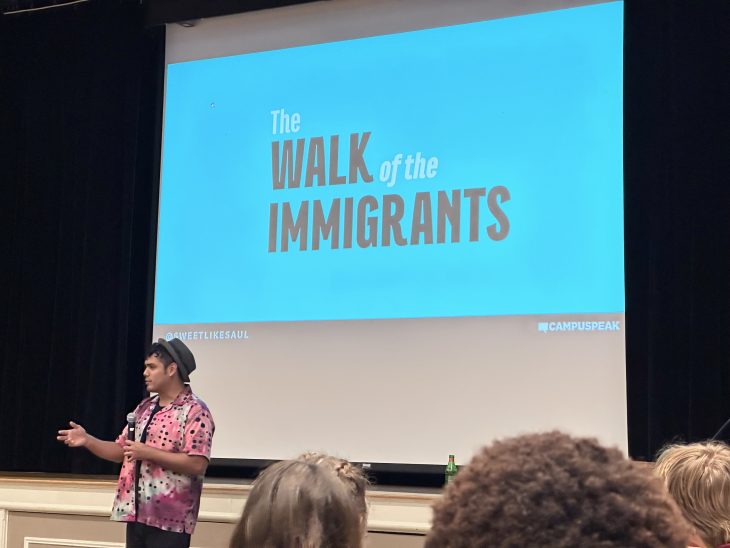
Watching a news broadcast with his mother, he saw a video of a young woman trying to swim across the Rio Grande, which separates Mexico and the United States. In the turbulent river, the young woman had a baby wrapped around her shoulder, trying to swim. One news anchor said it would make life easier if the river swallowed her whole. None of his family stopped to respond to the comment, but Flores was upset. He stated that he believed his family had become numb to this type of information and comments. He recalls his mother telling him, “They just don’t know. They don’t know our stories, our struggles, our hardships. They don’t know how hard it is for us to make these journeys across Latin America, not for opportunity but for a chance at opportunity.”
Flores said in this moment, he realized how complex my mother’s story was and how complex migration and education are.
“So, as the son of migrants, I decided to do something, and I created a project that was called the Walk of the Immigrants,” he said. The Walk of the Immigrants was simple, I would set four goals.”
The four goals of the projects were:
- Walk across 10 countries in Latin America from Quito, Ecuador, to Charlotte, North Carolina, to raise awareness for migration and education.
- Photograph the journey to document the brothers, sisters, mothers and fathers and use those images to introduce people to different parts of the country.
- Sell the photographs and use the proceeds to help reconstruct the school in Atencingo, Mexico.
- To make it home alive, a goal he said he shared with many migrants.
His current project, the Love Walk documentary, is now being filmed and focuses on three girls from the elementary school in his mother’s hometown.
Through these stories, Flores illustrated how differences impact a person’s story, ultimately impacting their perspective on how they can learn about and from diverse identities. Additionally, these stories connected to the conference theme, demonstrating how he is using his work to look out for himself, others, and the future.
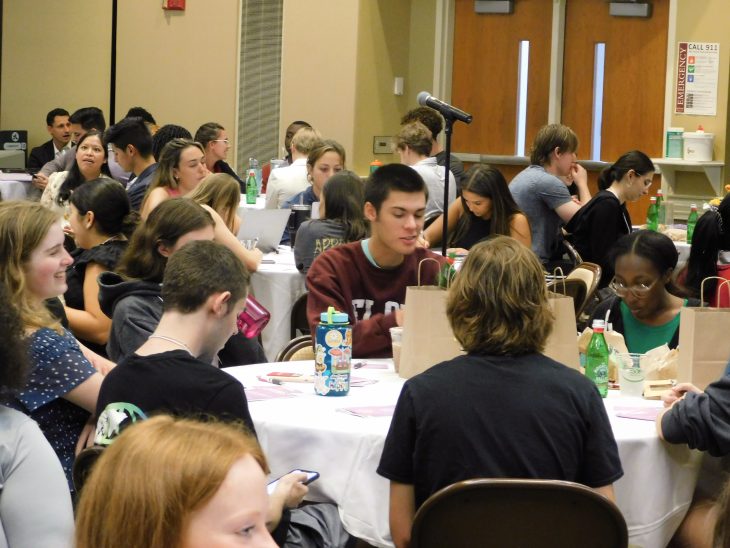
Look Out For Yourself
Attendees and conference staff also provided their perspectives on the “Look Out” conference theme and the impact of attending the conference.
“I feel like there’s a lot more formal setting training and conversation that the Intersect Conference will offer,” said Ben Neill ’25, a student at the University of North Carolina at Chapel Hill. “And I also think getting different perspectives from folks across the state, not just people at UNC or Elon, having an intersectional group at the Intersect conference, I think would be super beneficial for what I take away and what I bring back to Chapel Hil,”
Daniela Maldonado’25 shared the same sentiment, saying she was eager to learn different perspectives. “I just want to learn new perspectives on different topics,” Maldonado said. “I think that Intersect does a really good job of highlighting very important topics in everyone’s lives. So I’m really excited to get the opportunity to kind of understand different perspectives on those topics.”
Look Out For Each Other
Members of the conference committee shared what they hoped conference attendees would learn when discussing the theme and looking out for each other.
“I think one of the takeaways we want the attendees to take from this is to be more aware of other people’s identities and also take away things that they may not have heard before and learn new things. And take that and put them into practice as well,” said Leslie Aviles Mendoza ’25, Intersect Conference student director for marketing.
Intersect Conference volunteer coordinator, Jayla Martin-Beasley ’25, elaborated on key conference takeaways for attendees, discussing how sessions would allow them to look outward and inward. “I think a lot of the sessions are very, very good this year in letting people both look outward and inward,” Martin-Beasley said. “There are sessions going on about history and there’s the Mexican Revolution, for example. Then there are also sessions about looking inward, like with the imposter syndrome session. So I do kind of love that we’re going in multiple perspectives, so people are able to both look in themselves and look out and [will] also be able to come away with solid skills and solid knowledge that can then be used.”
Look Out For the Future
Sylvia Muñoz, assistant dean of students and director of the CREDE provided her perspective on the conference’s theme, “Look Out for the Future.”
“I hope that students and participants are able to learn different perspectives, learn a bit more about themselves, and also learn about other people because that’s the only way that they’re going to be able to protect not just their future but the future others as well,” Muñoz said.
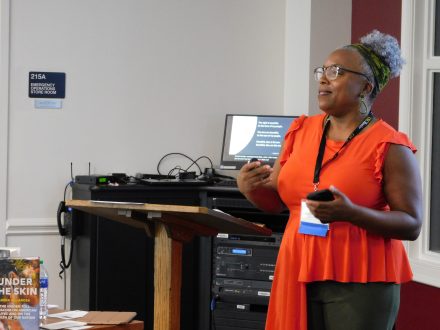
Other highlights of the Intersect conference included educational and roundtable sessions such as, “Man Enough: Lessons from Kendrick Lamar’s Mr. Morale & The Big Steppers,” “A Weatherproof Space | An affinity approach to weathering the intersecting storms of race and gender,” “Queering Leadership: A Transformative Framework,” “Pivotal Figures and Activism in Environmental Justice,” and “Value Expression & Leading Diverse Teams.”



